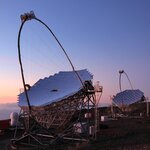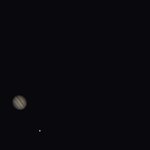Space
The Chinese Space agency has achieved something interesting by launching the first part of their own space station. This is not a breakthrough as space stations have been around for a while. More science done in space will inevitably be good for humanity. What is not good is the careless way they did their launch using a booster which will re-enter with no control at all, and which has a chance of hitting a populated area. Human habitation areas are so small relative to the surface of the Earth that it is unlikely that the spent rocket body will hit anywhere near…

About 23,000,000 years ago, something hit the giant Asteroid 4 Vesta(1) some 120,000,000 miles away and the impact sent huge rocks into space. In 2018, one such meteorite from that time hit Botswana.
It was not unique. Over 30 percent of such Howardite-Eucrite-Diogenites (HED) meteorites that hit Earth year come from just the impact that formed the Antonia crater on Vesta. And then there is everything else happening outside our atmosphere piling on.
We're being bombarded by space dust all of the time; about 10,000,000 pounds each year, according to a new paper.
Electron micrograph of a…

Thanks to cosmic rays that created radioactive isotopes while it was in space, an asteroid on an impact trajectory with Earth On June 2, 2018 was detected before it arrived.
Thanks to the isotopes in those fragments, researchers determined that 2018 LA, called such by the University of Arizona's Catalina Sky Survey as part of NASA's Planetary Defense program, was a solid rock about 1.5 m in size, which reflected about 25 percent of sunlight.
Eight hours later, a video camera in South Africa recorded a bright fireball over Botswana and the hunt was on for surviving meteorites deep inside…

On April 24th, 1990, the Hubble Space Telescope was launched, and though it had bumpy childhood once the problems were fixed it has well exceeded its mission expectancy. A good thing too. The James Webb Space Telescope that was supposed to replace it 13 years and billions of dollars ago still hasn't launched, and when it eventually does, if things don't work, no space shuttle can reach it.
So while we have it, let's enjoy this image of AG Carinae, surrounded by an expanding shell of gas and dust, a nebula. that is shaped by the powerful winds of the star. The nebula is about five light-years…

[This is the second part of a two-part article on Cosmic Messenger astrophysics. For part 1, please click here.]
We can also "see" showers of secondary particles from cosmic rays thanks to the Cherenkov light they produce. Cherenkov light is emitted when charged particles travel in a medium at speeds higher than the speed of light itself! Light, in fact, slows down a little when it traverses a medium; energetic particles do not, so they create a conic "shock wave" similar to the boom of supersonic airplanes.
By imaging these light cones, ground-based instruments watching the sky detect…

Orbital mechanics have dictated that the USA, UAE and PRC who sent probes to arrive at mars formed a defacto fleet of probes to the Red Planet. Arriving next week NASA and the PRC will independently be landing probes at Mars. When the rover Curiosity landed at Mars via a risky jet pack landing. It was the first time the “sky crane” had been tried. This time it will be done among even more daunting terrain. The most amazing part of it all is that it has to be done by the computers on the craft itself. There is no way it could be remotely controlled. From Earth as even at the speed of light, at…

Have you ever looked up to a clear sky on a moonless night, in a place away from large cities? If you have, you will remember seeing hundreds of bright stars, and maybe even the faint collective glow of 250 billion more within the Milky Way, our own galaxy.
[Above: the milky way. Image credit: Symmetry magazine]
Ever since we realized that every star we see is a distant Sun like our own, we have been awed by the vastness of our Universe. There is so much out there we do not know! It makes us feel insignificant; and yet, by observing the sky we have the power to learn about the Universe and…

An international research team has discovered an exotic binary system composed of two young planet-like objects, orbiting each other - and not a star.
They are planet-like because they look like giant exoplanets but they formed in the same way as stars, proving that the mechanisms driving star formation can produce rogue worlds in unusual systems - deprived of a Sun.
Star-forming processes sometimes create mysterious astronomical objects called brown dwarfs, which are smaller and colder than stars, and can have masses and temperatures down to those of exoplanets in the most extreme cases.…

In what is a once-in-a-few-lifetimes experience, I witnessed today the conjunction of Jupiter and Saturn in the evening sky (with a crescent moon thrown in to boot). While every sixteen years or so the two planets end up angularly close because of their different orbital period (Jupiter revolves around our Sun in 11.9 years, Saturn takes 29.4 years), small differences in their orbital planes make the smallest distance they reach usually of the order a degree. Any of those "regular" conjunctions is still fun to watch, as both planets shine with negative magnitudes in the night sky,…

Meteor showers are a spectacular phenomenon that takes place when the Earth intersects the path along which periodic comets (or less frequently, asteroidal bodies) orbit the Sun. Comets lose debris when they get close to perihelion, but the debris does not get lost in all directions - it continues to follow the comet's path in the solar system.
When our planet plunges in that "gas" of particles of all sizes, from ones as small as micrometric specks of dust to ones as large as boulders, a shower occurs. It may last a few hours to full weeks, and it typically reaches a few hours-lasting…